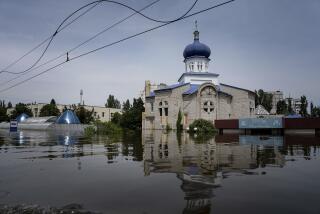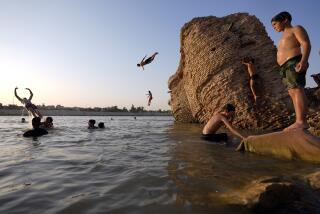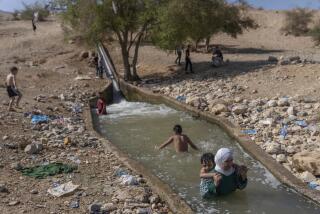Parched Iraq, Syria Jittery as Turks Divert Euphrates to Power Project : Middle East: The river will flow for at least one month into a giant reservoir, linchpin in network of hydroelectric and irrigation facilities.
DAMASCUS, Syria — Turkish engineers Saturday halted the flow of the Euphrates, one of the world’s great rivers, sending a flood of jitters through downstream, drought-stricken Syria and Iraq.
The water will be diverted for one month into the reservoir behind Turkey’s giant new Ataturk Dam, linchpin of a network of hydroelectric and irrigation projects along the upper reaches of the Euphrates and Tigris rivers in eastern Anatolia.
In the Middle East, where water politics are excruciatingly sensitive, neither the Syrian nor Iraqi governments has openly opposed the diversion. But they have reason for concern.
“The Ataturk Dam has the potential to hold two years’ flow of the Euphrates,” said a Western diplomat. “I’d be bloody nervous living downstream.”
The Turks have pledged to resume the flow at previous levels on Feb. 13, but even that rate has fallen short of Syrian needs. The water level in Lake Assad, the big Syrian dam on the Euphrates, is so low that only one of its eight hydropower turbines is working, according to published reports.
In Iraq, further downstream, the flow is further diminished and has been polluted by pesticides from upstream agricultural projects.
“We have to cut the water for a month. There can be no debate about this,” Turkish Public Works Minister Cengiz Altinkaya declared recently in Ankara, the Turkish capital. But even if there was no open debate, there were urgent talks among Turkish, Syrian and Iraqi officials over the past two months.
And shadowing the technical talks was a political cloud, the public threat last September by Turgut Ozal, then Turkey’s prime minister and now its president, to block the Euphrates if Syria did not restrain Kurdish and Armenian guerrillas who Ozal charged were raiding Turkish villages and had training bases in Lebanon’s Syrian-controlled Bekaa Valley.
With foresight, a 1987 report on the Middle East by Washington’s Center for Strategic and International Studies noted: “Before the 21st Century, the struggle over limited and threatened water resources could sunder already fragile ties among regional states and lead to unprecedented upheaval within the area.”
Diminishing or insufficient water resources threaten current and future development throughout the Arab countries: an 11-year drought along the Nile threatened power generation at Egypt’s Aswan High Dam until the heavy rains of 1988. Development in the Persian Gulf states is draining and polluting the aquifer that supplies their water. Syria, Jordan and Israel are competing for the waters of the Jordan River and its main tributary, the Yarmuk.
Here in Syria, where the economy is heavily dependent on agriculture, water supplies are a year-to-year problem. The rains were good in 1988, but drought struck last year. Three-quarters of the barley crop was lost for lack of rain in the northeast, where there is no river-fed irrigation.
“It was not a wet fall,” said a foreign economic analyst. “If they get a good rain this spring, they may be OK.”
In the village of Maaloula, in the rimrock country of the central belt northeast of Damascus, Hanna Qalouma led a visitor to the well on his farm Friday.
“See there,” he said, pointing to the dark water about 10 feet below the wide, concrete rim. “I have just over two meters left. Last spring I could run my pump 7 or 8 hours a day. Now, only one.”
Over a sweet tea, Qalouma talked of the good times and the bad. Last year, he said, kicking at the hard earth with his Wellingtons, the village got less than four inches of rain. Normal rainfall in Maaloula is 10 inches.
“We’ve had two good years in the last 10,” the farmer said. “If we get the spring rains, maybe we’ll be all right. But right now, it doesn’t look good.”
Last year’s drought killed off his 30-year-old orchard of apricot trees, though a younger stand survived. Last spring, his cherry trees budded, but a late snow damaged the crop.
Things were no better with his livestock. About eight cows, a gaggle of aggressive geese and a band of young pigs (Maaloula is a Christian village in Muslim Syria) roamed about his rock-terraced farm.
“I can’t afford to keep the cows,” Qalouma said. “The market price is low, but feed costs too much, so I’ll have to sell them anyway. Anyone with cows in this village is losing money.”
The one-month diversion of the Euphrates will not directly affect Maaloula and other drought-stricken areas of central Syria far from the river’s course.
The anticipated short-term difficulties will occur along the stretch from the Turkish border to Lake Assad in northern Syria.
“Downriver from Lake Assad, the Syrians can regulate the flow with what water they have in the reservoir,” remarked the foreign analyst. “But above the lake, the Euphrates will be fed only by tributaries coming in on this side of the Ataturk Dam.”
Has Own Problems
Despite controlling the snow-fed headwaters of the Euphrates and Tigris, the twin rivers that nourished the ancient civilizations in what is now Iraq, Turkey has water problems of its own.
“Last year was worst in 54 years,” a Damascus-based Turkish diplomat told a reporter last week, describing drought conditions in eastern Anatolia, a region of poor farmers.
The $11-billion Southeast Anatolian Project is designed to bring power and irrigation to the region through a series of more that 20 dams, with completion targeted just after the turn of the century.
The largest reservoir will be the Ataturk, rising behind a 552-foot dam 40 miles upstream from the Syrian border. The hydroelectric system is expected to be operational by 1992. Turkish authorities have described the reasons for the one-month blockage of the river as “technical,” and the governments of Syria and Iraq, after tripartite consultations, have apparently accepted the rationale.
In announcing the cutoff, the Turks said they were temporarily increasing the flow of the Euphrates to allow the two downstream countries to build up supplies to help carry them through the monthlong shutdown.
In a July, 1987, meeting, Turkish leader Ozal and Syrian President Hafez Assad agreed on bilateral cooperation in a number of areas, including gas and oil development and, according to the Turks, a Euphrates flow of 500 cubic meters a second at the Syrian border. But the Turks are largely calling the shots on the flow of the vital Euphrates waters.
The governments in Damascus and Baghdad “don’t have any objections, and they can’t object” to shutting down the Euphrates for a month, Turkish Foreign Ministry spokesman Murat Sungar said recently.
More to Read
Sign up for Essential California
The most important California stories and recommendations in your inbox every morning.
You may occasionally receive promotional content from the Los Angeles Times.










